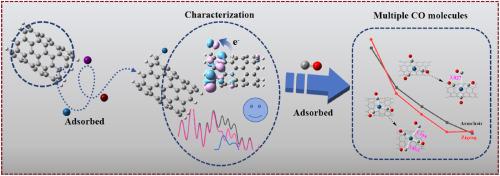DFT study of carbon monoxide adsorption on metal (Pt, Ni, Rh)-decorated single-walled carbon nanotubes
IF 3.9
Q3 PHYSICS, CONDENSED MATTER
引用次数: 0
Abstract
The adsorption of CO on metal (Pt, Ni and Rh)-decorated armchair and zigzag single-walled carbon nanotubes (SWCNT) were investigated by using density functional theory (DFT) to assess the potential as the CO sensors. The results indicate that the geometric configurations and electronic structures of the complexes undergo significant changes upon metal and CO adsorption, with only minor deformation of the SWCNT. The calculated adsorption energies of CO on Pt-decorated SWCNT(7,0) and Pt-decorated SWCNT(4,4) are 2.36 eV and 2.20 eV, respectively, which are notably higher than those for CO on Ni- or Rh-decorated SWCNT. Pt-decorated SWCNT exhibit the strongest chemical adsorption with CO among the metal-decorated SWCNT. Natural bond orbital (NBO) analysis reveals that CO acts as an electron donor while the metal-decorated SWCNT function as the electron acceptor. Additionally, the HOMO-LUMO gap (Δε) of metal-decorated SWCNT decreases after CO adsorption, with a minimum value of 0.378 eV observed for SWCNT(7,0)-Pt-CO. The conductivity of Pt-decorated SWCNT is altered upon CO adsorption, indicating that Pt-decorated SWCNT could serve as the effective CO gas sensor at room temperature. The study also suggests that the maximum CO to Pt ratio in SWCNT-Pt-(CO)n is 3:1, which would be helpful for the CO sensors design.

金属(Pt, Ni, Rh)修饰的单壁碳纳米管对一氧化碳吸附的DFT研究
采用密度泛函理论(DFT)研究了金属(Pt、Ni和Rh)装饰扶手椅和锯齿形单壁碳纳米管(SWCNT)对CO的吸附性能,并对其作为CO传感器的潜力进行了评价。结果表明,配合物的几何构型和电子结构在金属和CO的吸附过程中发生了显著的变化,而swcnts的变形很小。计算得到CO在pt修饰SWCNT(7,0)和pt修饰SWCNT(4,4)上的吸附能分别为2.36 eV和2.20 eV,明显高于CO在Ni或rh修饰SWCNT上的吸附能。在金属修饰的碳纳米管中,铂修饰的碳纳米管对CO的化学吸附作用最强。自然键轨道(NBO)分析表明,CO作为电子给体,而金属修饰的swcnts作为电子受体。此外,金属修饰的SWCNT的HOMO-LUMO间隙(Δε)在CO吸附后减小,SWCNT(7,0)-Pt-CO最小值为0.378 eV。在CO吸附过程中,镀pt修饰的swcnts的电导率发生了变化,表明在室温下,镀pt修饰的swcnts可以作为有效的CO气体传感器。研究还表明,swcnts -Pt-(CO)n中CO与Pt的最大比值为3:1,这将有助于CO传感器的设计。
本文章由计算机程序翻译,如有差异,请以英文原文为准。
求助全文
约1分钟内获得全文
求助全文
来源期刊

Computational Condensed Matter
PHYSICS, CONDENSED MATTER-
CiteScore
3.70
自引率
9.50%
发文量
134
审稿时长
39 days
 求助内容:
求助内容: 应助结果提醒方式:
应助结果提醒方式:


